From the colossal Kaluga sturgeon to the minuscule killifish, the many wonderful fish that start with the letter K come in a multitude of different shapes and sizes. Some are bold and colorful like the stunning ornamental koi, while others have unique traits, like the knifefish and its electro-sensitive organs. So, let’s dive right into the fascinating realm of these extraordinary fish!
1. Kaluga (Huso dauricus)
The largest freshwater fish in the world is the Kaluga. This incredible fish that starts with K can grow up to 20 feet long and weigh over 2,000 pounds! Kaluga fish live in Russia’s Amur River Basin. They are predatory sturgeons, with gray green to black bodies and yellowish-green or white underbellies. Although they are freshwater animals, Kaluga fish spend some of their lives in saltwater to spawn. Unfortunately, these enormous fish were nearly hunted to extinction. Today, fishing for Kaluga is illegal, but their populations continue to struggle due to poaching, habitat loss, and climate change.
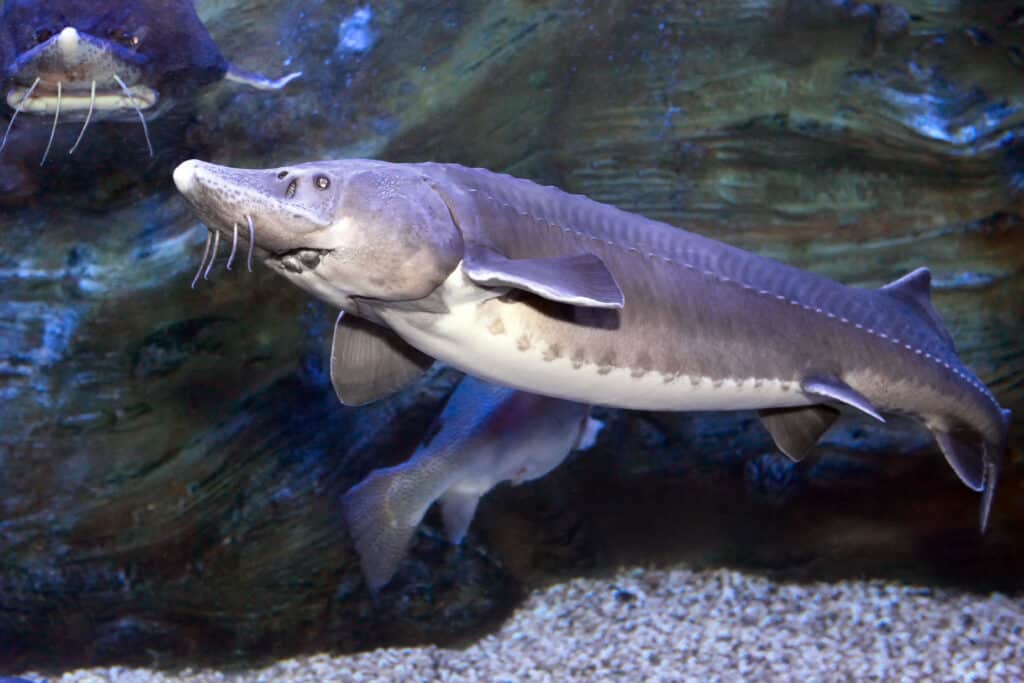
Most people don’t eat the meat of Kaluga
sturgeon
. Instead, they are highly prized for their roe or caviar.
©Tatiana Belova/Shutterstock.com
2. Kissing Gourami (Helostoma temmincki)
Native to Southeast Asia, kissing gouramis are adorable freshwater fish. Their unique, thick lips protrude and look like they’re kissing! Although they may look cute, those lips are lined with hundreds of little teeth. Kissing gouramis grow around 6 inches long and are either a greenish-silver color or pinkish-rosy color. The green gouramis have dark brown, opaque fins and long stripes on their bodies. The pink ones, in contrast, have transparent pink fins with silvery scales. Kissing gouramis are popular as pets in aquariums. They are social fish but may nip at the fins of smaller, more peaceful fish.
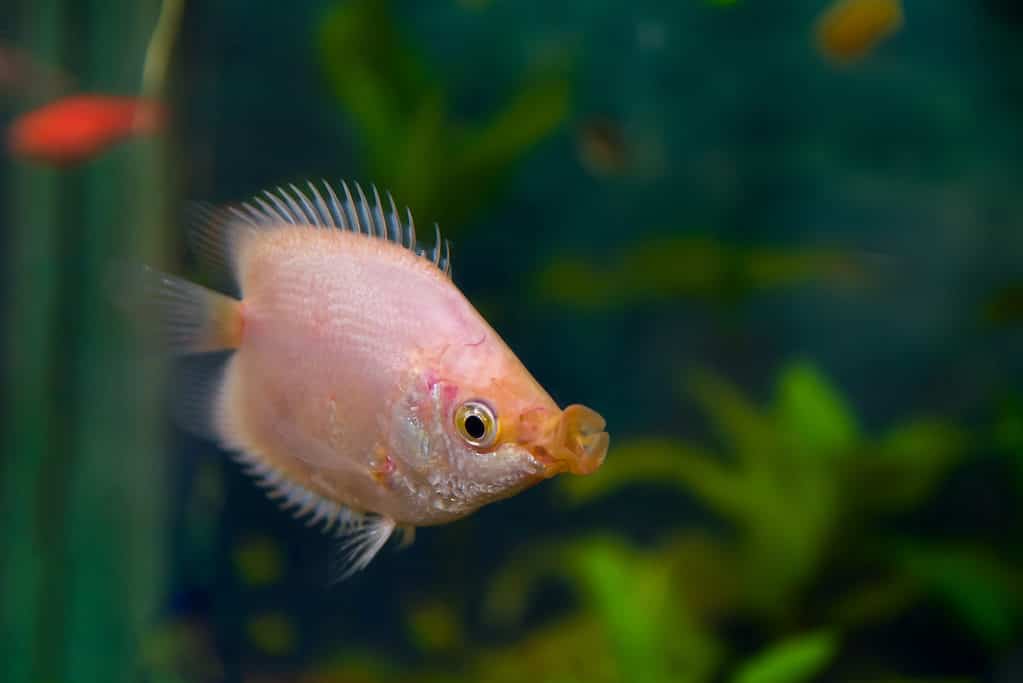
The kissing gourami is one of the most iconic species in the Gourami family.
©Evgenii Predybailo/Shutterstock.com
3. Kenyi Cichlid (Pseudotropheus lombardoi)
Another popular aquarium fish that starts with K is the Kenyi cichlid. Kenyi cichlids are aggressive freshwater fish native to Lake Malawi in Africa. Their slender bodies grow about 4 to 5 inches long, and males and females each have their own unique appearance. Male cichlids have bright yellow bodies with black vertical stripes, while female cichlids are a green or pale blue color with much fainter vertical stripes. In the wild, Kenyi cichlids live in harem groups, with 20 to 30 female fish and one dominant male.
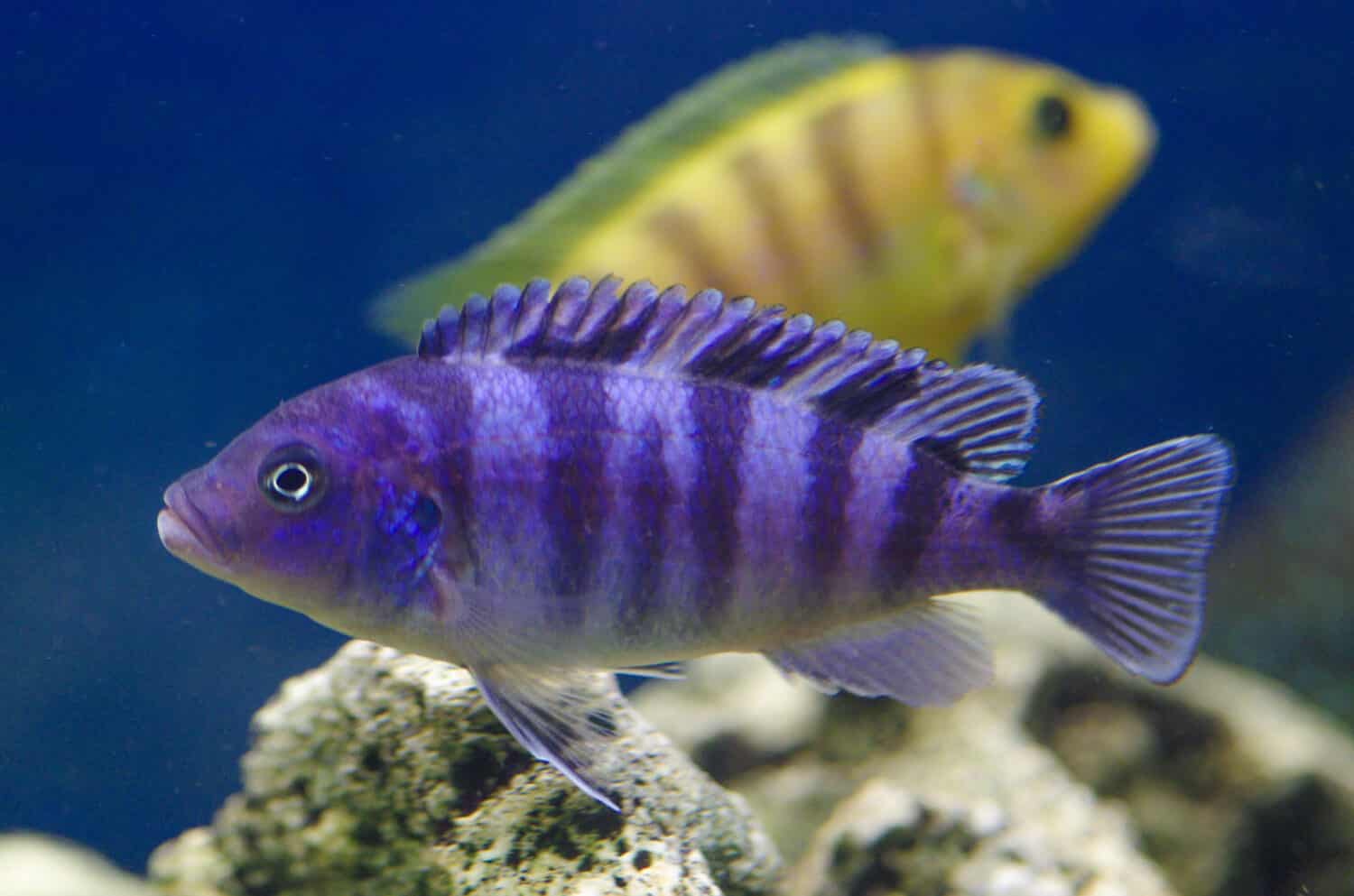
Kenyi cichlids can live 10 to 15 years.
©Natalia Sidorova/Shutterstock.com
4. Keyhole Cichlid (Cleithracara maronii)
The keyhole cichlid is also a popular aquarium fish, but much less aggressive than the Kenyi cichlid. Keyhole cichlids come from the Amazon River Basin in South America and are shy, non-aggressive fish. Their name comes from the distinct black spot on the back of their bodies. As they get older, this spot will sometimes extend downwards and begin to look like an old-fashioned keyhole. Keyhole Cichlids are peaceful and timid fish. They are small and only reach about 4 inches in length at most, with slightly compressed bodies.
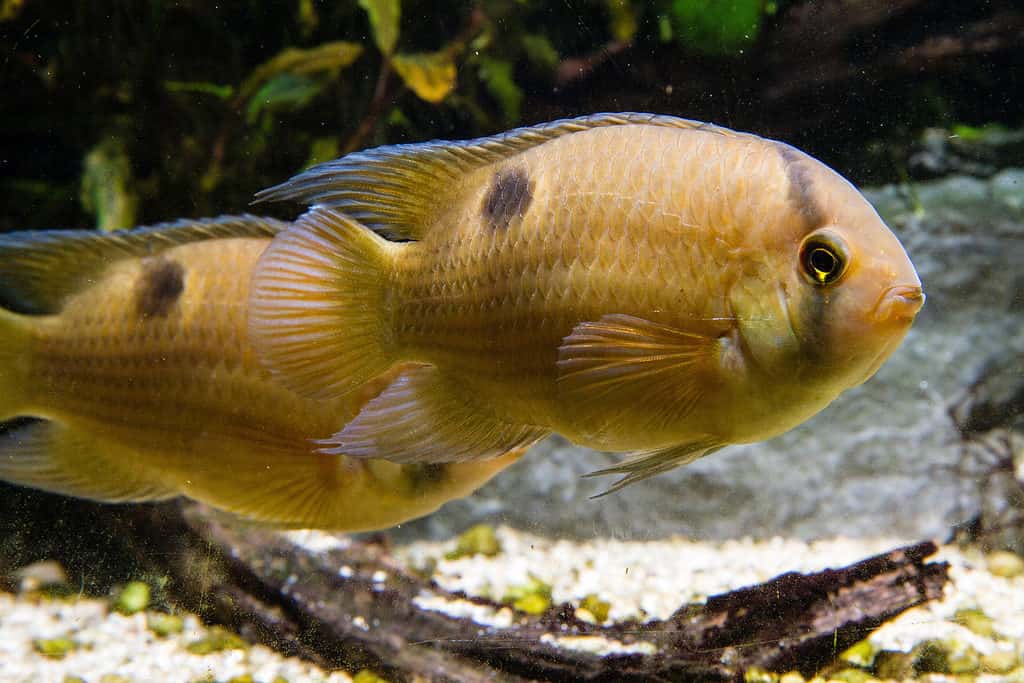
Keyhole cichlids don’t usually bother other community fish or even plants or decorations in a tank.
©chonlasub woravichan/Shutterstock.com
5. Killifish (Cyprinodontiformes)
There are actually over 1,200 different species of killifish! Killifish are very colorful freshwater fish that come in all sorts of shapes sizes and colors. They live in many different freshwater habitats, like rivers, streams, and ponds. Killifish are also popular as aquarium fish, and there are many different types to choose from. Some have bold, bright colors, while others are more muted and low-key. However, it’s important to do your research when choosing a particular species, as some types of killifish are more aggressive than others.
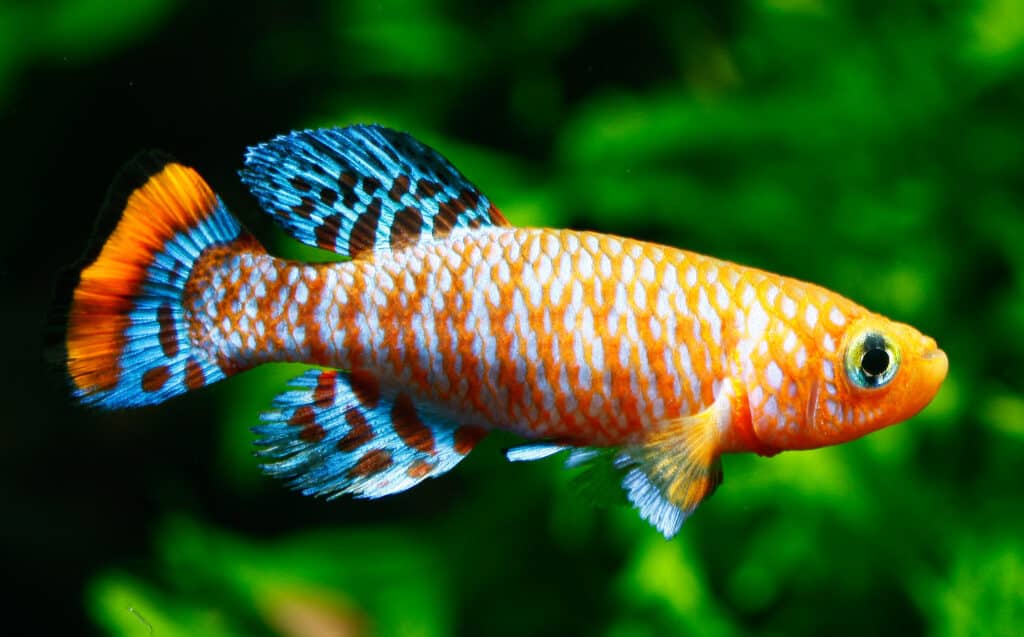
Many species of killifish have striking beautiful colors, making them very popular among fish enthusiasts.
©Pavaphon Supanantananont/Shutterstock.com
6. Knifefish (Gymnotiformes)
The knifefish certainly doesn’t look like any old ordinary fish. These unusual-looking fish have long slender bodies and snouts shaped like knife blades. The strangest part of their appearance, however, is their elongated anal fins. Knifefish use these unusual fins to swim, undulating in a wave-like pattern.
In addition to their unique appearance, knifefish also have many extraordinary adaptations. They can actually produce and use electric fields to navigate, communicate, and detect prey hidden in the mud. Knifefish are native to South America in the Amazon River basin. A few species are sold as pets for aquariums, such as the black ghost knifefish (Apteronotus albifrons).
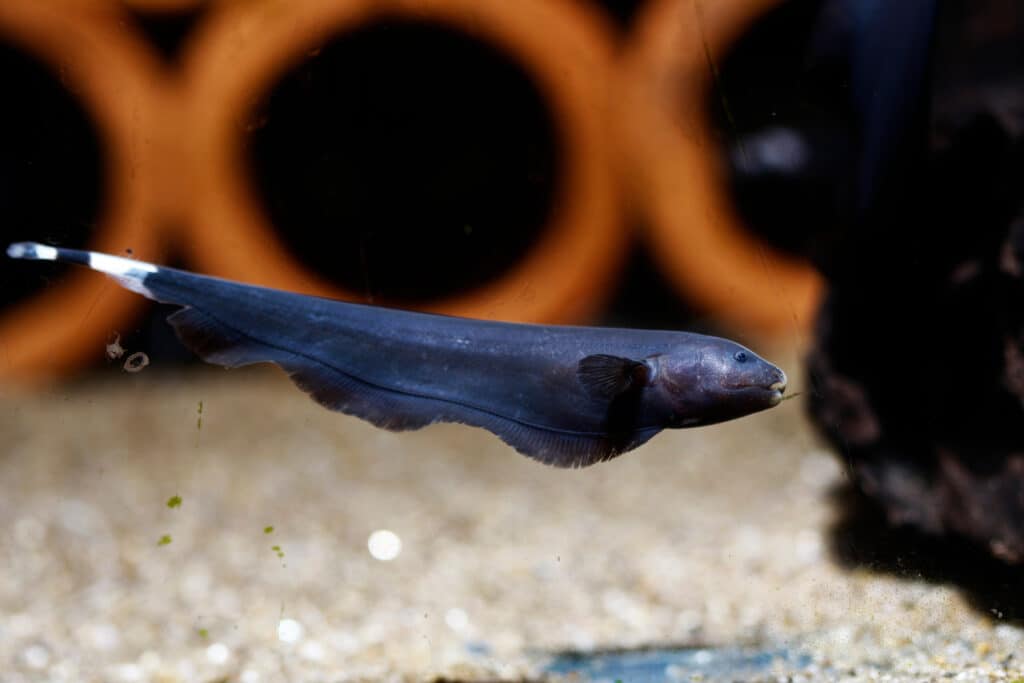
Knifefish swim by rippling their anal fins while keeping their bodies rigid.
©Pavaphon Supanantananont/Shutterstock.com
7. Koi (Cyprinus rubrofuscus)
Carp are a diverse group of fish originally discovered in Central Europe and Asia. In Japan, during the nineteenth century, skilled breeders began working to achieve ornamental varieties. Today these vibrantly colored Koi carp are often found gracing the serene settings of outdoor ponds, lush water gardens, and even water hazards at golf courses.
Ornamental Koi come in a wide range of colors and patterns, from white and black to red, yellow, orange, brown, blue, and cream. Some even have sparkling gold and silver scales. Koi can live for a very long time, from 15 years to more than 50 years. However, the oldest on record, a scarlet koi fish named Hanako, reportedly lived to be an incredible 226 years old!
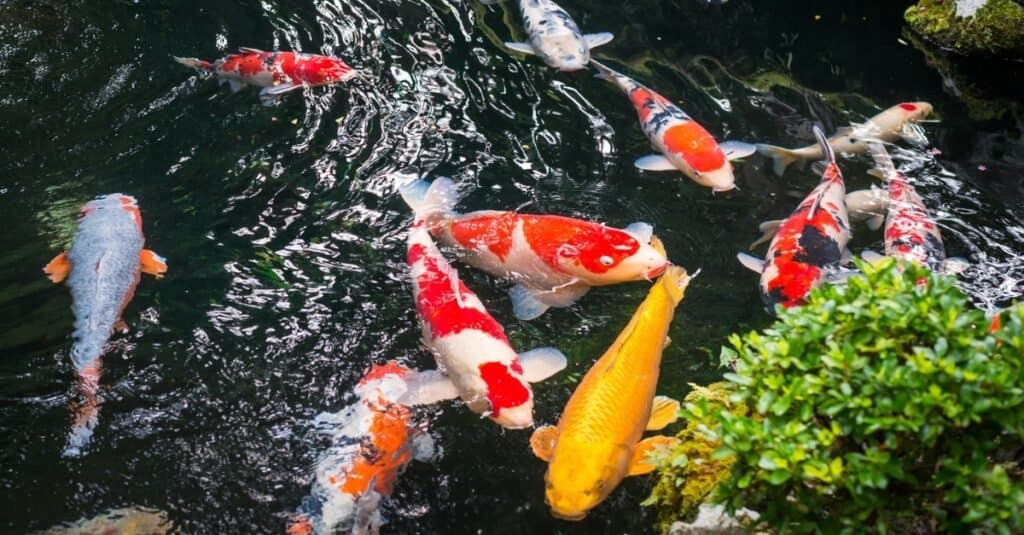
Koi live in cold water but can adapt to many different conditions and climates.
©M_MUC1968/Shutterstock.com
8. Knifejaw (Oplegnathus)
There are about 12 different species of knifejaw fish, each with different colors and patterns. The spotted knifejaw (Oplegnathus punctatus), for example, can grow over 3 feet long, with vertical stripes and spots decorating its body. The Cape knifejaw (Oplegnathus conwayi), on the other hand, has a dark grey body without any distinctive patterns. Knifejaws are marine fish with unique parrot-like beaks, which they use to crush crustaceans, barnacles, mollusks, and small fish.
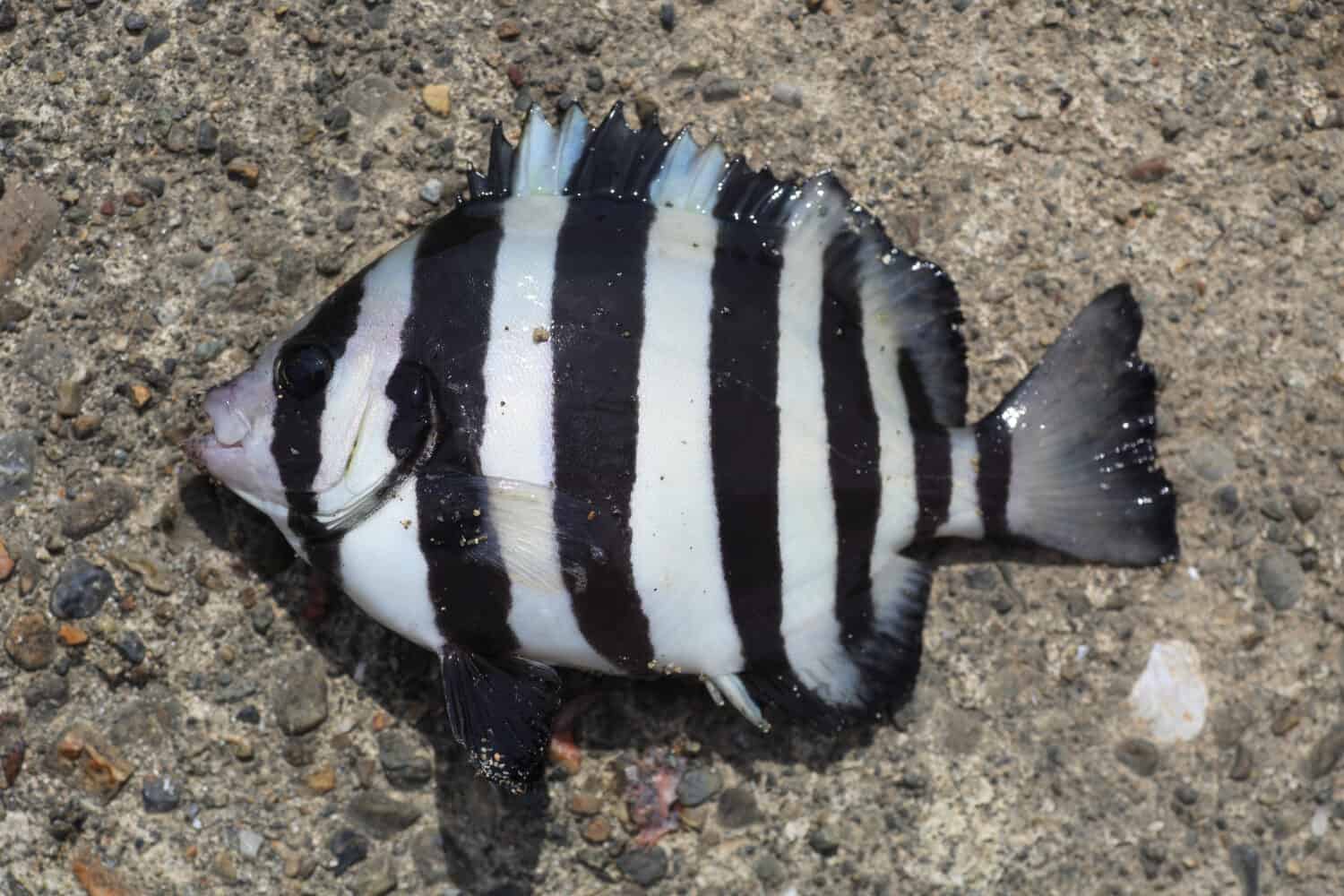
The striped beakfish (
Oplegnathus fasciatus) is a striking species of knifejaw.
©feathercollector/Shutterstock.com
9. Kivver (Lepomis gibbosus)
This interesting fish that starts with K goes by many different names: pumpkinseed, common sunfish, sunny, pond perch, punkie, and of course, kivver. But whatever you call these fish, they are absolutely stunning! Kivvers are one of the most colorful and vibrant freshwater fish you’ll find, with iridescent blue, yellow, orange, or green speckles covering their bodies. In addition, many fish have orange spots on their fins and blue lines across their cheeks. There are also faint blue or green vertical stripes along their sides and a distinct orange-red spot on the edge of their gill covers. These beautiful fish are typically about 4 inches long, but sometimes grow up to 11 inches.

Kivver fish live in warm, calm waters like small rivers, creeks, and ponds.
©Fabian Junge/Shutterstock.com
10. Kadango Cichlid (Copadichromis borleyi)
These unique cichlid fish that start with K come from Lake Malawi in Africa. Male cichlids have a metallic blue color on their faces and fins, with orange or red covering the rest of their bodies. Females, on the other hand, are gray with red or orange fins. Kandango cichlids grow about 8 inches long, and they are fairly peaceful fish. When they are not breeding, both females and males can live together in harmony.
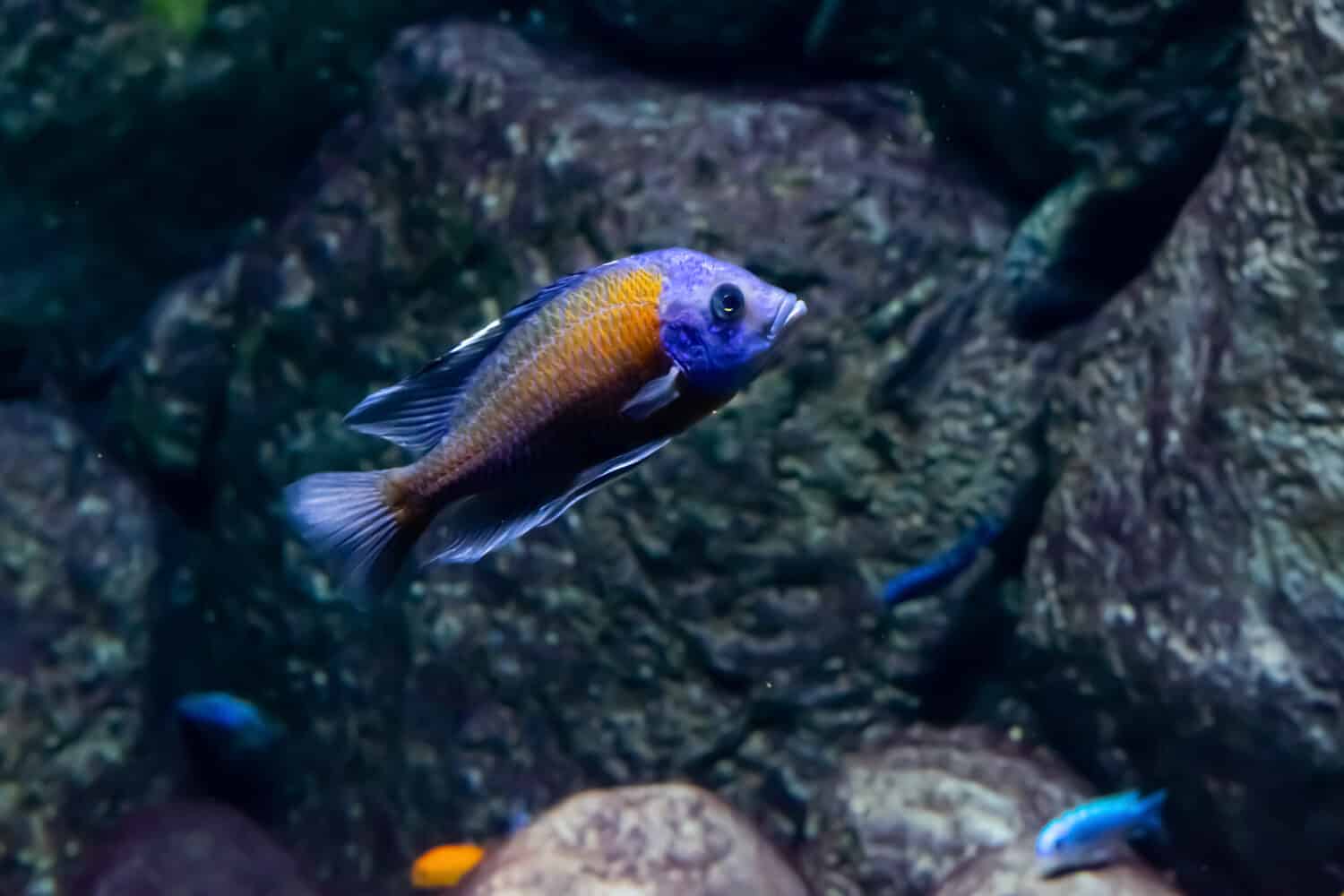
Kadango cichlids live in both shallow and deep areas of Lake Malawi.
©Sunny_Smile/Shutterstock.com
11. Kribensis Cichlid (Pelvicachromis pulcher)
Another peaceful and beautiful cichlid fish that starts with K is the Kribensis cichlid. Its body is a classy gray or white, which contrasts beautifully with its long and pointed fins. These elegant fins are edged with red and yellow, with bold black spots. Some also have metallic blue streaks, and female cichlids also have reddish-pink bellies.
Kribensis cichlids typically are peaceful, although they don’t do as well if mixed with other caved-dwelling species. In addition, these cichlids sometimes nip at other fish with long flowy tails.
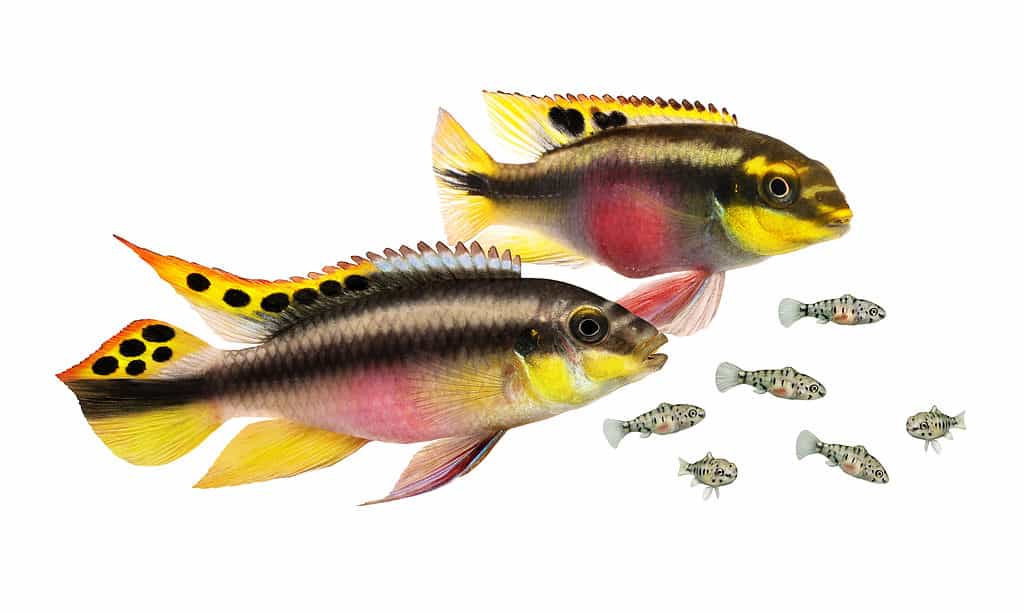
Kribensis cichlids are also called rainbow cichlids or rainbow kribs due to their spectacular coloring.
©iStock.com/Mirko_Rosenau
12. Kokanee Salmon (Oncorhynchus nerka)
Found in the Northern Pacific Ocean and its connecting rivers, the Kokanee salmon lives in both saltwater and freshwater environments. Most of their lives are spent in the ocean’s saltwater, but during spawning they can migrate up to 1,000 miles to freshwater habitats for spawning.
In the ocean, Kokanee salmon are blue with silver hues, but during the spawning season, their bodies transform into a beautiful bright red and green. After spawning, the salmon die. Their offspring remain in freshwater until they are large enough to travel to the ocean.

Some populations of Kokanee salmon do not actually migrate to saltwater habitats to spawn.
©IrinaK/Shutterstock.com
13. Kafue Pike (Hepsetus cuvieri)
These predatory freshwater fish live in southern Africa, growing to about 10 inches in length. Lurking in oxbow lakes and deep-water channels, Kafue pike are ambush predators who mainly feast on other fish. They have long slender bodies with dark brown mottling and sharply pointed snouts.
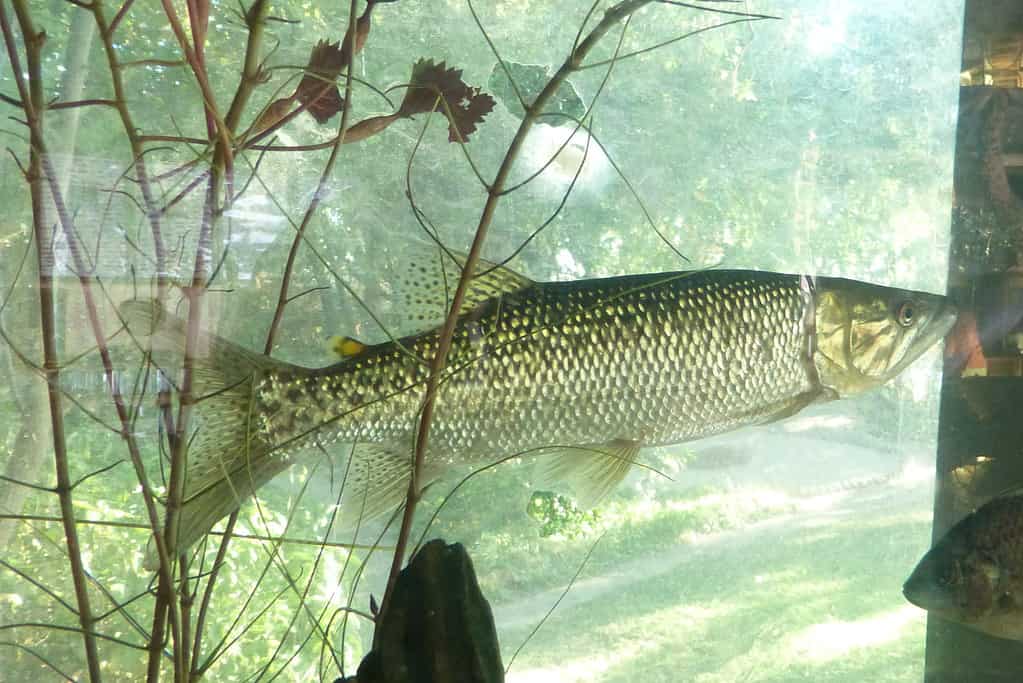
The Kafue pike is also referred to as the Kafue pike characin and the African Pike.
©Alex Giltjes / CC BY-SA 3.0 – License
14. Kuhli Loach (Pangio kuhlii)
Native to Southeast Asia, the Kuhli loach is a small and peaceful bottom-dweller. Emerging from their hiding places at night, they scavenge and forage for food scraps. In the wild, Kuhli loaches live in slow-moving rivers and mountain streams, but they are also popular pets in aquariums. Kuhli loaches are peaceful fish that help keep aquariums clean and do well with other community fish. They are not schooling fish, but they still have a social side and often live together in small groups. Kuhli loaches are small and grow only 3 to 4 inches long.
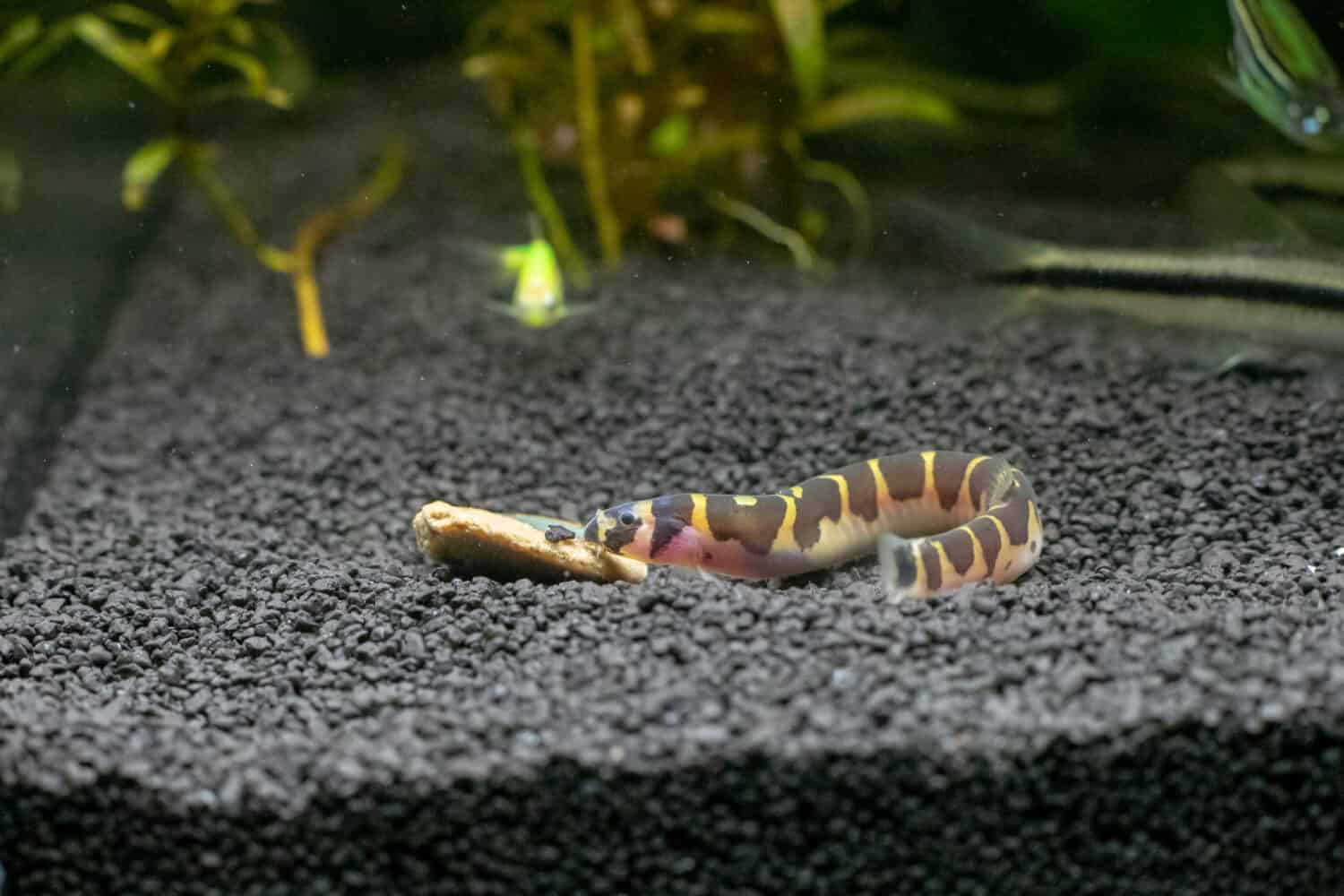
Kuhli loaches make excellent additions to aquarium “cleaning crews”.
©Olga Chezhina/Shutterstock.com
15. Kyburz Tetra (Pseudochalceus kyburzi)
Found in the Amazon River Basin in South America, the Kyburz tetra is a small schooling fish that only grows around 3 inches long. Kyburz tetras have a long black stripe that runs from behind each eye down to the base of the tail fin and tiny bright orange spots. They are not common in aquariums and are rarely seen even in the wild. Kyburz tetra are fast-moving fish and can be aggressive, so they should never be housed with tankmates that have long fins or move slowly.
16. Knight Goby (Stigmatogobius sadanundio)
Another small fish that starts with K is the knight goby, growing to just 3.5 inches long. Although small knight gobies are voracious fish that will eat just about anything that they can fit into their mouths. They are gray-blue fish with dark spots and live in freshwater and sometimes brackish water. In the wild, they are found in many places, from Pakistan to India, Sri Lanka, Bangladesh, Cambodia, Thailand, Singapore, Malaysia, Fiji, and Indonesia. They can be territorial, so if kept in an aquarium they will need plenty of hiding spaces.
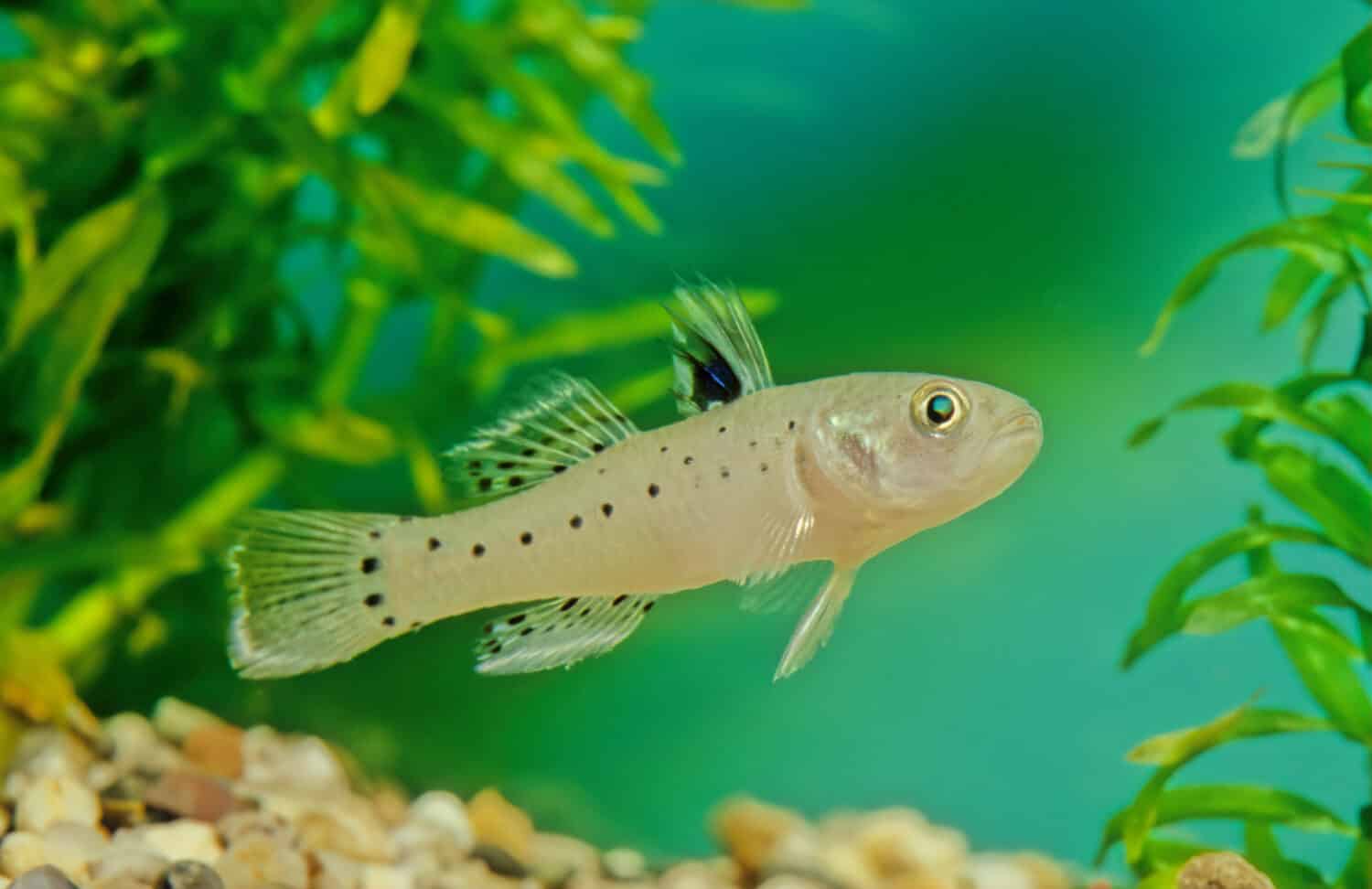
Knight gobies are beautiful aquarium fish, but they stress easily with bright lighting.
©Roberto Dani/Shutterstock.com
17. Katangae Nile Bichir (Polypterus bichir katangae)
The Katangae Nile Bichir only lives in the Democratic Republic of the Congo, typically in shallow flood plains, estuaries, rivers, and swampy habitats. It is a unique fish that doesn’t actually have a dorsal fin. Instead, there are unique dorsal inlets running along the top of its body, making it look like a dinosaur or dragon. In fact, in fish stores, it is often called “dragon fin” or “dragon bichir”. In addition, it has very thick and bone-like scales. Katangae Nile Bichir fish range in size, growing from 9.8 inches up to nearly 40 inches long. They may look imposing, but they are surprisingly peaceful predators.

Bichirs have small openings called spiracles on top of their heads to help them breathe air.
©Les poissons des eaux douces de l’Afrique occidentale : du Sénégal au Niger Pellegrin, Jacques, 1873-1944 / Public Domain – License
18. Kingsley’s Ctenopoma (Ctenopoma kingsleyae)
Kingsley’s ctenopoma is a freshwater fish that lives in Northwestern Africa. Growing 8 to 12 inches long, these fish prefer areas with dim lighting and lots of rocks, bogwood, and dense plants for hiding. However, they are also active swimmers who need plenty of space. They can be aggressive fish but also jump out of the water to escape predators.
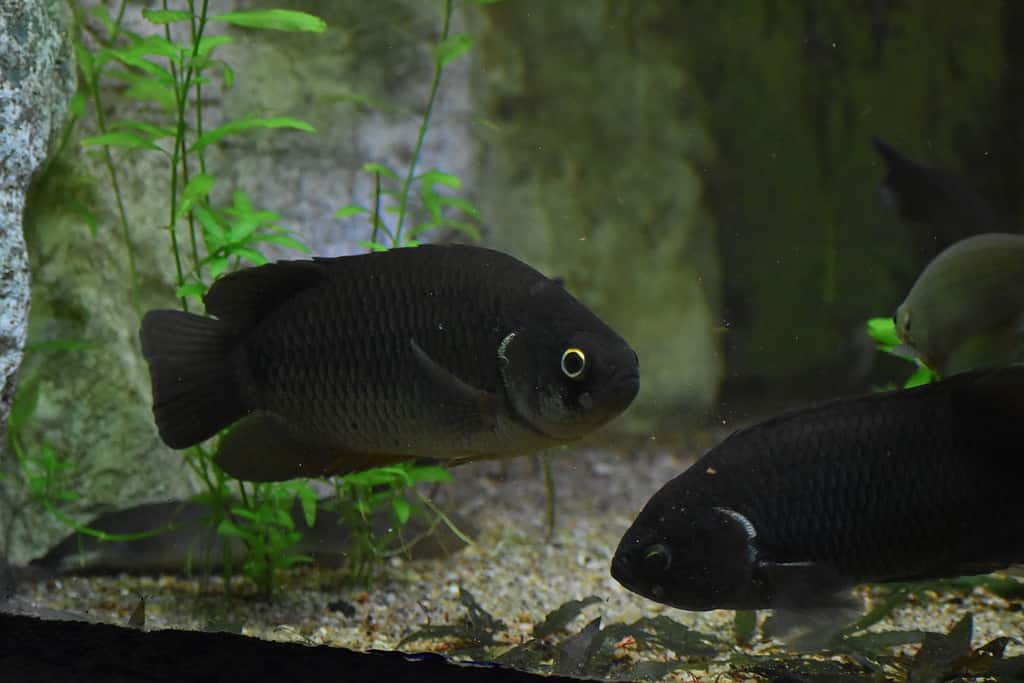
Kingsley’s ctenopoma is also called the tailspot ctenopoma.
©Tylwyth Eldar / CC BY-SA 4.0 – License
19. Kner’s Banjo Catfish (Dysichthys knerii)
Native to South America, Kner’s banjo catfish (or the Ecuador banjo catfish) lives in the Amazon River basin, the Orinoco River basin, and the coastal rivers of Ecuador. It is a small fish and only grows 4 to 5 inches long. It has a flat head and body, and its tail area is rather skinny, making it look like a banjo.
Kner’s banjo catfish is usually brown or olive with darker spots, and its skin has tubercles or large bumps all over, making it look like a strange type of finned toad. These fish usually live in areas with a soft or sandy substrate where they can bury themselves and ambush any edible prey that happens to pass by.
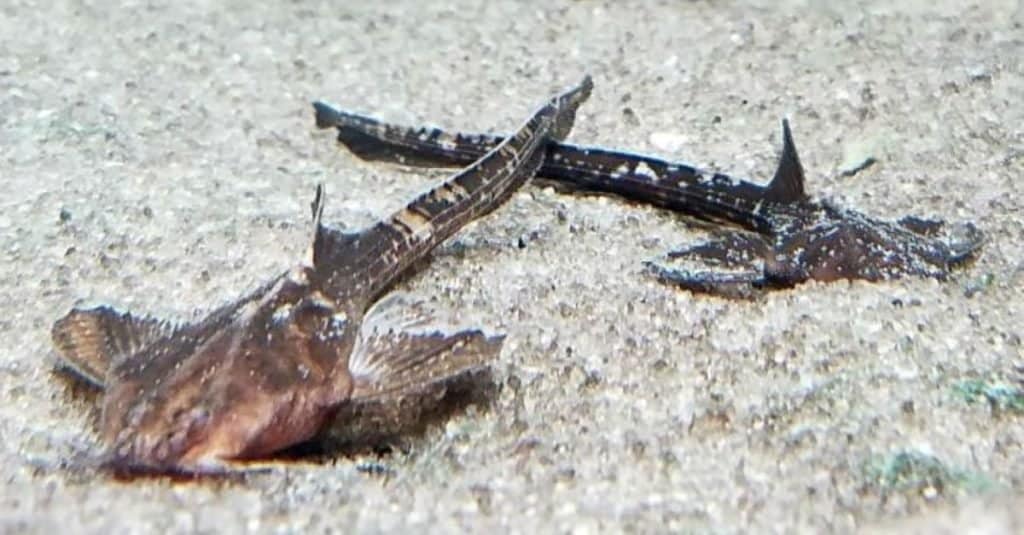
20. Kelpfish (Chironemus)
Adapted to shallow waters with lots of movement, kelpfish live along the coasts of the Southern Pacific Ocean off New Zealand and Australia. There are about 10 different species, growing to 16 inches long at the most. Kelpfish have pointed snouts and special nose tubes that stick out like tufts. Their slender bodies are pinkish, green, or brown with dark-colored spots. Their back or dorsal fins are long with strong spines, and their small anal or bottom fins have thick spines.
Kelpfish often live in weedy areas on reefs or in kelp forests, where they hide themselves in small niches and between rocks. They secure their bodies in place with their long pectoral fins, particularly when there is a lot of wave action.
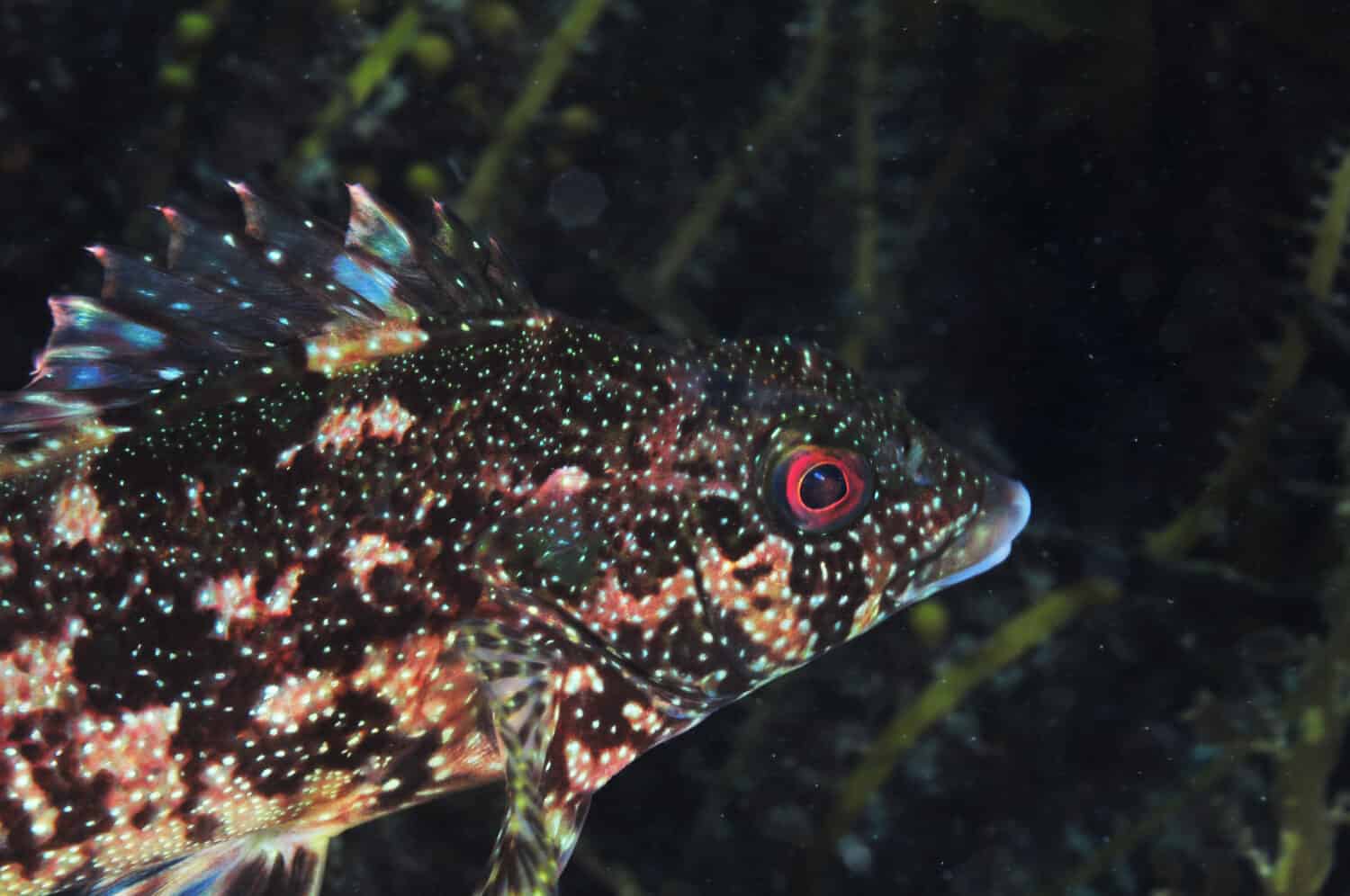
The large or eastern kelpfish eats invertebrates like small crabs, sea urchins, and mollusks.
©Daniel Poloha/Shutterstock.com
21. Knife Livebearer (Alfaro cultratus)
Growing only up to 3 inches long, knife livebearers live along the surface of rivers, streams, and backwater areas in Panama, Nicaragua, and Costa Rica. They are beautiful and slender fish, with sparkling iridescent blue along their yellowish, ethereal bodies. Knife livebearers are peaceful fish and do well in aquarium settings with other calm community fish. However, they are schooling fish so they should be kept together in groups of at least six or more. Like their name, female knife livebearers give birth to live young.

Knife livebearers get their name from two roles of scales near their tails, which are shaped like knives.
©Andrzej Zabawski/Shutterstock.com
22. Kōkopu (Galaxias)
The kōkopu is endemic to New Zealand, where it lives in various swamps, lakes, and rivers. There are only three species of kōkopu. The giant kōkopu is the largest, measuring up to 20 inches long with an olive-brown body covered in pale yellow dots. The banded kōkopu (Galaxias fasciatus) is a bit smaller and has pale yellow vertical stripes. And here’s a fun fact: young banded kōkopu fish are pretty talented and can actually climb up vertical waterfalls!
The smallest is the shortjaw kōkopu, which is only 7 to 8 inches long with sparse vertical stripes and spots. Unfortunately, the populations of all three species have been decreasing in recent years due to pollution, non-native species, and habitat loss.
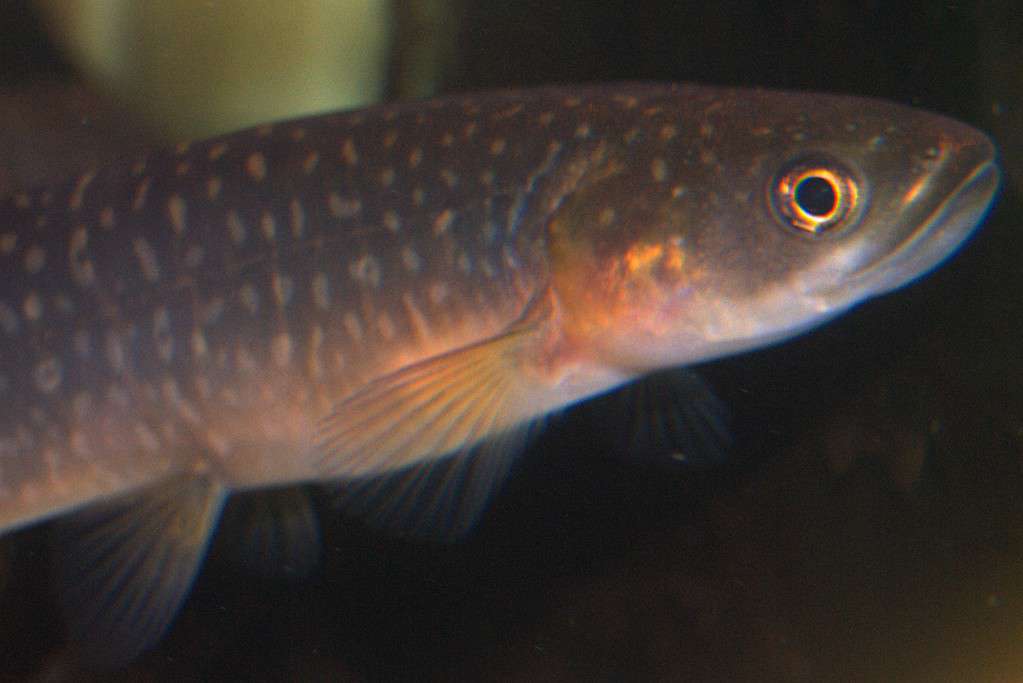
Giant kōkopu live in freshwater, usually near the coast, but their young migrate to the ocean to grow.
©Blueether / CC BY-SA 3.0 – License
23. King Mackerel (Scomberomorus cavalla)
Native to the Western Atlantic Ocean and the Gulf of Mexico, the king mackerel is a migratory fish that usually grows 11 to 30 pounds. However, on rare occasions, some can grow as large as 90 pounds! King mackerels have torpedo-shaped bodies covered with minuscule, almost imperceptible scales that seem to barely cling to their skin. They are opportunistic carnivores and are popular in both recreational and commercial fishing. These voracious predators can swim up to 40 mph as they chase down sardines, herring, squid, and crustaceans.
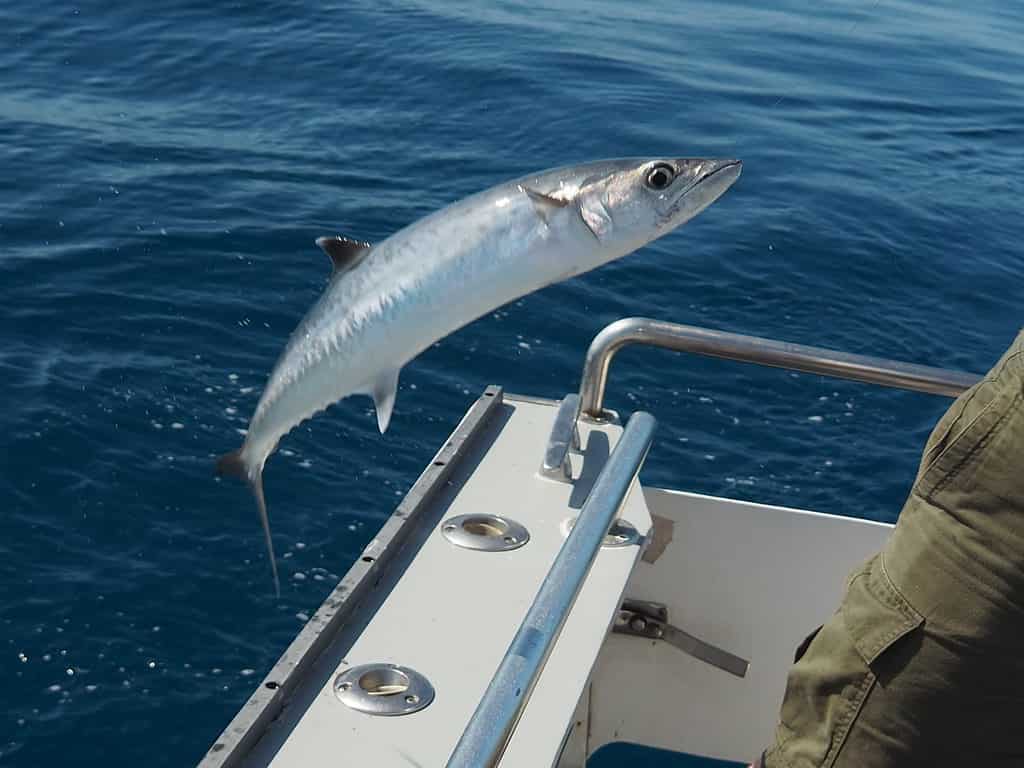
King mackerel fish are mostly gray and silver.
©Coastal Girl/Shutterstock.com
24. King-of-the-Salmon (Trachipterus altivelis)
The fascinating King-of-the-Salmon can be found in the eastern Pacific Ocean. A type of large ribbonfish, the King-of-the-Salmon can grow up to 6 feet long! It is a deep-sea fish and typically lives up to 3,000 feet below the surface of the ocean.
The King-of-the-Salmon gets its name from the Makah people of the Pacific Northwest Coast. According to legend, this massive fish leads other salmon to their spawning grounds each year, ensuring a successful salmon run. It is forbidden to catch or kill a King-of-the-Salmon, as this could cause the other salmon to be led astray and fail to reach their destination.
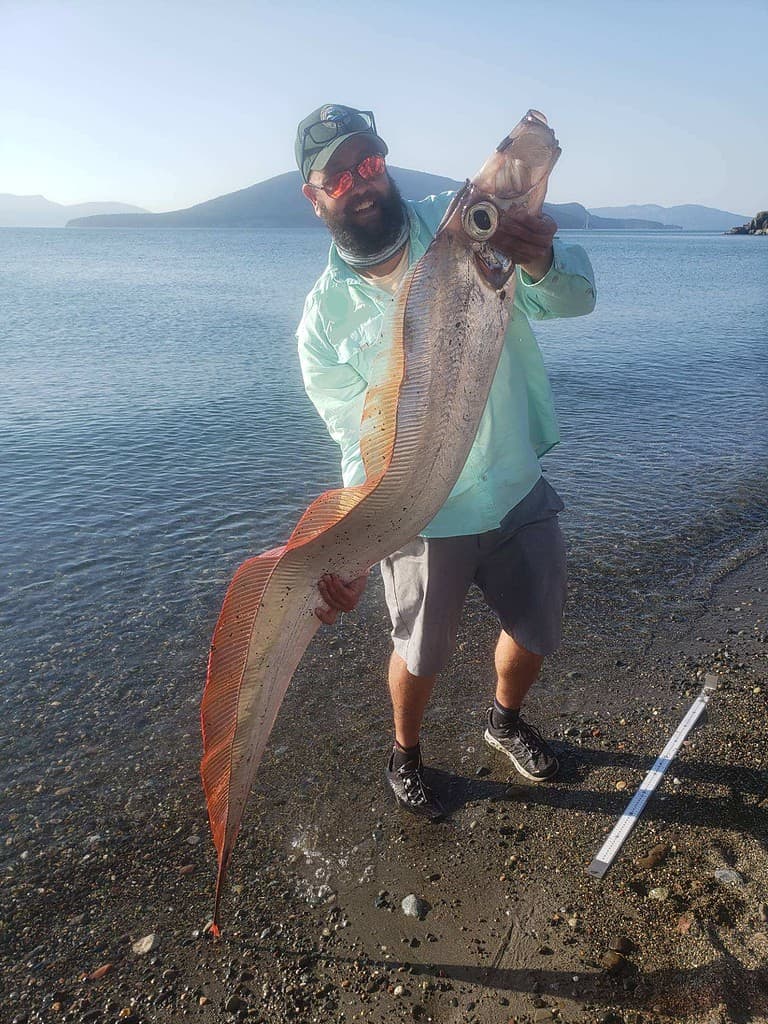
King-of-the-Salmon have ribbon-like bodies, with a dorsal fin that stretches along their length.
©Awkward Salmonid / CC BY-SA 4.0 – License
The Largest Fish That Starts K
The largest fish that starts with K is the massive Kaluga (Huso dauricus) from the Amur River Basin in Russia. This gargantuan sturgeon can grow nearly 20 feet long and weigh over 2,200 pounds! In addition, it can live to be 80 years old!
Unfortunately, however, Kaluga sturgeon are an endangered species. Kaluga populations decreased by more than 80 percent from the late 1800s to the 1990s. Although Kaluga fishing is now outlawed, there are still many poachers who continue to decimate their numbers. Even in just the last 10 years, their numbers have decreased. Many poachers take the large female fish, which means that aren’t as many left behind to produce new generations of Kuluga sturgeon. In addition, Kaluga sturgeon mature later on in life and only spawn every three to five years, so increasing their population takes a long time.
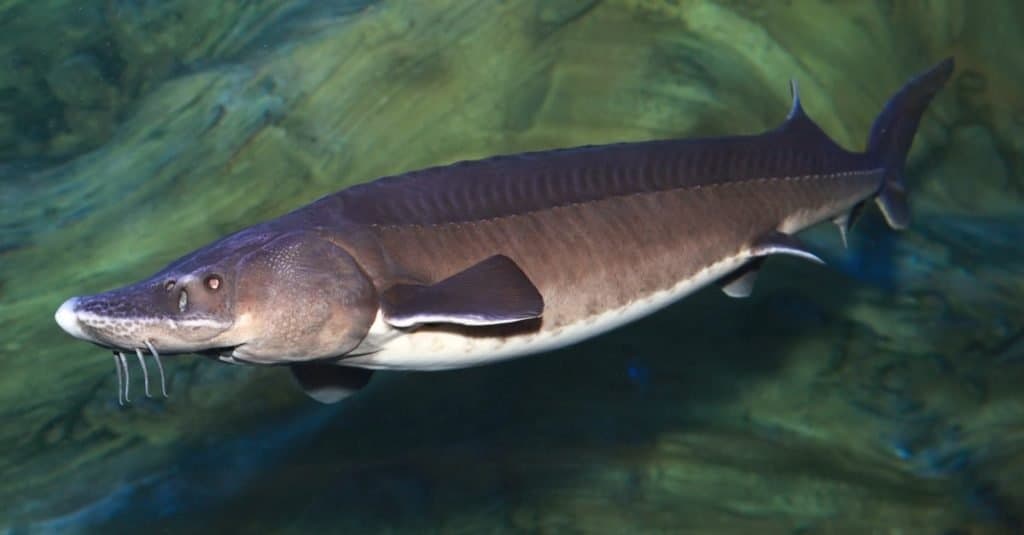
Kaluga sturgeon are predatory fish with immense appetites. They eat almost any type of fish or shellfish.
©Tatiana Belova/Shutterstock.com
Summary of 20+ Fish That Start With K (Common Names)
| Common Name | Scientific Name |
|---|---|
| Kaluga | Huso dauricus |
| Kissing Gourami | Helostoma temmincki |
| Kenyi Cichlid | Pseudotropheus lombardoi |
| Keyhole Cichlid | Cleithracara maronii |
| Killifish | Cyprinodontiformes |
| Knifefish | Gymnotiformes |
| Koi | Cyprinus rubrofuscus |
| Knifejaw | Oplegnathus |
| Kivver | Lepomis gibbosus |
| Kadango Cichlid | Copadichromis borleyi |
| Kribensis Cichlid | Pelvicachromis pulcher |
| Kokanee Salmon | Oncorhynchus nerka |
| Kafue Pike | Hepsetus cuvieri |
| Kuhli Loach | Pangio kuhlii |
| Kyburz Tetra | Pseudochalceus kyburzi |
| Knight Goby | Stigmatogobius sadanundio |
| Katangae Nile Bichir | Polypterus bichir katangae |
| Kingsley’s Ctenopoma | Ctenopoma kingsleyae |
| Kner’s Banjo Catfish | Dysichthys knerii |
| Kelpfish | Chironemus |
| Knife Livebearer | Alfaro cultratus |
| Kōkopu | Galaxias |
| King Mackerel | Scomberomorus cavalla |
| King-of-the-Salmon | Trachipterus altivelis |
The photo featured at the top of this post is © InsectWorld/Shutterstock.com
Thank you for reading! Have some feedback for us? Contact the AZ Animals editorial team.







